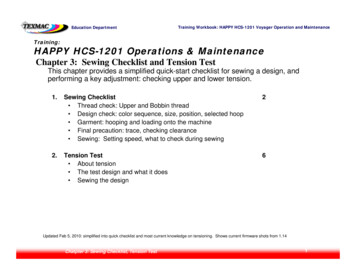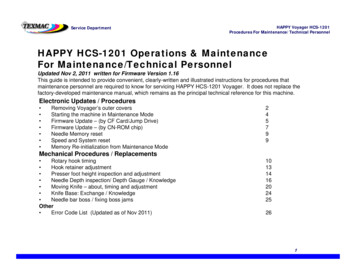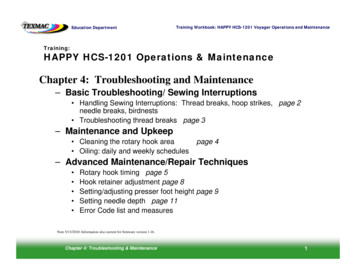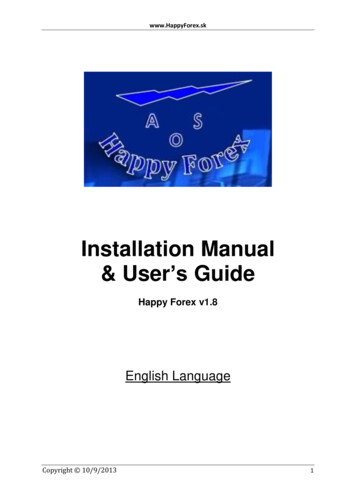
Transcription
Education DepartmentTraining Workbook: HAPPY HCS-1201 Voyager Operation and MaintenanceTraining:HAPPY HCS-1201 Operations & MaintenanceChapter 3: Sewing Checklist and Tension Test1. Set-up Checklist2. Tension TestThis chapter provides a simplified quick-start checklist for sewing a design, andperforming a key adjustment: checking upper and lower tension.1.Sewing Checklist Thread check: Upper and Bobbin thread Design check: color sequence, size, position, selected hoop Garment: hooping and loading onto the machine Final precaution: trace, checking clearance Sewing: Setting speed, what to check during sewing22.Tension Test About tension The test design and what it does Sewing the design6Updated Feb 5, 2010: simplified into quick checklist and most current knowledge on tensioning. Shows current firmware shots from 1.14Chatpter 3: Sewing Checklist, Tension Test1
Education DepartmentTraining Workbook: HAPPY HCS-1201 Voyager Operation and Maintenance1. Sewing Checklist1.1. Set-upSewingChecklistChecklist2. Tension TestThread Check: Upper and Lower thread.Upper tensioner: ½turn, runs betweenthe disks.– Bobbin thread: Properly threaded?Tension checked OK?Inserted fully into the hook basket?Rotary hook door CLOSEDSensor wheel: ½turn, runs insidewheel groove.Insert bobbincase FULLY intohook.– Upper thread:Referencing the diagram on the right, Are all the colors needed for the design fully threaded? No loose threads hanging anywhere (docked in holder springor in holder behind needle) Thread feeds smoothly without catching when test pulledthrough the needle. Needles oriented properly: eye front-back, scarf facing the rear.Chatpter 3: Sewing Checklist, Tension TestSpool: Thread flowsfreely, no hang-ups.Lower tensioner: Fullturn, thread in grooveof metal wheelLower head: Properly upand down takeup lever,check spring, grommets.Needle oriented with eyefront-back, scarf in rear.Thread through front ofeye, end docked in springor thread holder.2
Education DepartmentTraining Workbook: HAPPY HCS-1201 Voyager Operation and Maintenance1. Sewing Checklist1.1. Set-upSewingChecklistChecklist2. Tension TestDesign Check: Upper and Lower thread.– Needle Screen: Color sequence is set?Refer to the image of the Needle (color setup) screen shownon the right: (Optional) Color palette matches actual thread colorson each needle (ensures accurate design preview) Needle number assigned to every color block?(For blocks with unassigned needle # (value “0”),machine will stop sewing and prompt for a color.– Frame Screen: Positioned in a selected hoop?Referencing the diagram on the right on the Frame screen, Has the hoop been selected that matches the actual hoopthat will be used? Is the design outline (in blue) inside the red safety line? Has a trace been run?Chatpter 3: Sewing Checklist, Tension Test3
Education DepartmentTraining Workbook: HAPPY HCS-1201 Voyager Operation and Maintenance1. Sewing Checklist1.1. Set-upSewingChecklistChecklist2. Tension TestGarment: Hooping and Loading on the Machine– HoopingAligned andpositionedcarefully.Refer to the image of the Needle (color setup) screen shownon the right: Hoop: Use the smallest that fits the design size. Backing/Stabilizer: Choose the right type. Shouldbe large enough to overlap edges of hoop underthe garment. Alignment and position: If the hoop isn’t alignedon the garment, it won’t sew straight! Round holes at bottom: Make sure hoop is onthe shirt so that round are towards the operator.Opposite end is towards machine. Tight but not too tight! Garment and backing should haveno slack or wrinkles inside hoop. Adjustment screwtightened enough to hold garment in hoop while sewing,but no more.– Loading the Garment & HoopReferencing the diagram on the right on the Frame screen, Positioning pins on arm must snap into round holes onend of hoop to prevent unhooping during sewing. Sewing arm goes INSIDE the garment, not UNDER,or machine will sew front and back of garment together! Loose items tucked out of the way. (sleeves, straps, etc) Heavy items supported where possible to prevent item fromfalling out of hoop. Sleeves, and body can rest on table orchair underneath or to the side of machine if needed. Reinforcehoop with clamps or tape if needed.Chatpter 3: Sewing Checklist, Tension TestBackingpositionedcorrectly underNot too tight!Bad: Hood isjammed underbetween hoop &sewing arm. Pullabove hoop andtuck out of the waywhen sewing.Positioning pin shouldsnap into round holes.Sewing arm goesINSIDE thegarment. Don’t sewthe front & backtogether!Support un-sewn parts ofgarment where practical.4
Education DepartmentTraining Workbook: HAPPY HCS-1201 Voyager Operation and Maintenance1. Sewing Checklist1.1. Set-upSewingChecklistChecklist2. Tension TestSewing Your Design– SpeedHere are some rules to determine sewing speed: Do not sew at top speed all the time. Higher speeds putgreater tension on threads increasing thread break risk anddegrading sewing quality slightly. Strike a balance between high speed and vibration/noise.The steadier the table the machine is on, the faster you cango.– Watch it sew.A lot can be learned from watching the first few runs of agarment sew. Watch for: Efficient digitizing – are there a lot of unnecessary colorchanges and trims eliminated? Was the design createdin the most efficient sequence? Does it tend to breakthread in certain spots? Quality of the sew-out – quality problems can be fixedwith adjustments to tension, hooping, or editing back insoftware. Garment behavior during sewing: Does the garment move freely throughout thesewout, or does it get caught anywhere? Does it stay firmly in the hoop or does itslip? Does it wrinkle or shift as stitches are applied to it?Chatpter 3: Sewing Checklist, Tension TestSpeed control – adjustsmax allowable sewingspeed.Actual speed indicated heredepends on length of currentstitches being sewn. Stitcheslonger than 3mm will sew at lessthan top speed allowed.5
Education DepartmentTraining Workbook: HAPPY HCS-1201 Voyager Operation and Maintenance2. Upper Tension Test and Adjustment1. Set-up Checklist2. TensionTension TestTest2.A useful example is to sew a tension test, which not only walks you through thecomplete process of sewing a job, but also accomplishes the task of helping you adjustthe tension on the upper (colored) thread. Follow the steps in this exercise to (1) tosew the design, then (2) adjust tension accordingly until tension is properly adjusted.At this spot, the upper threadtemporarily caught onsomething, pulling bobbinthread to the top side.1.Transfer the tension test design called “HTest12” into your control panel. You can download thisfrom www.happyemb.com in the Service section.2.Ensure that the bobbin tension has been set correctly using the droptest. (review Chapter 2 page 5 – “Bobbin Loading and Tension”3.Set the color sequence In the Needle screen to 1, 2 ,3 .etc to 124.Hoop an ideal fabric (2 layers of cutaway backing is usually good enough)5.Sew a sample on the 32 cm square hoop.6.Examine the results by looking at the reverse side. Check each satinsample to ensure there is a white strip of bobbin thread 25%-33% in thecenter. Then, if:- Bobbin strip is very thin or non-existent: that thread is veryloose. Tighten using the upper tension knob for that needle.-Bobbin strip is a little thin but consisten: that thread is slightlyloose. Tighten using the upper tension knob for that needle.-Bobbin strip is wide to a large degree, some of it being pulledaround to the front: That thread is very tight. Loosen using theupper tension knob for that needle.- Bobbin strip is only slightly wide: The thread is slightly over-tight.Loosen using the lower tensioning knob for that thread.7.Note: Make big adjustments. Whichever knob needs to be tightened or loosened, make several turns to tighten or loosen.Colored thread far tooloose. Tighten withupper knob.These are slightly too loose. Tightenusing the lower tension knob.On re-sewing, these 3 sample colors look a lot better.Chatpter 3: Sewing Checklist, Tension Test6
Updated Feb 5, 2010: simplified into quick checklist and most current knowledge on tensioning. Shows current firmware shots from 1.14 Chapter 3: Sewing Checklist and Tension Test This chapter provides a simplified quick-start checklist for sewing a design, and performing a key adjustment: checking upper and lower tension. 1. Sewing Checklist 2










